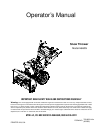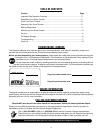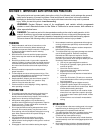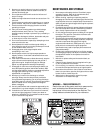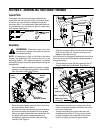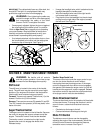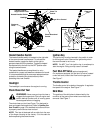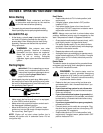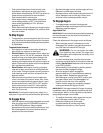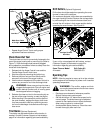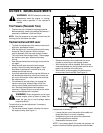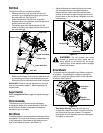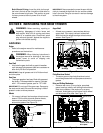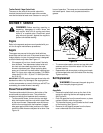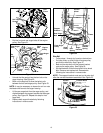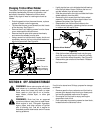
9
• Push primer button two or three times for cold
engine start, making sure to cover vent hole in
primer button when pushing. DO NOT use primer to
restart a warm engine after a short shutdown.
• Push starter button to start engine.
• When engine starts, release starter button and
move choke gradually to OFF. If engine falters,
move choke immediately to FULL and then
gradually to OFF.
• When disconnecting the power cord, always unplug
from the three-prong receptacle first, and then from
the snow thrower.
To Stop Engine
• To stop engine, remove the ignition key. Do not turn
key. Disconnect the spark plug wire from the spark
plug to prevent accidental starting while equipment
is unattended.
To prevent starter freeze-up:
• Run engine for a few minutes before stopping to
help dry off any moisture on the engine.
• Electric Starter: Connect power cord to switch box
on engine, then to 120 volt AC receptacle. With the
engine running, push starter button and spin the
starter for several seconds. The unusual sound
made by spinning the starter will not harm engine or
starter. Disconnect the power cord from receptacle
first, and then from switch box.
• Recoil Starter: With engine running, pull starter
rope with a rapid, continuous full arm stroke three
or four times. Pulling the starter rope will produce a
loud clattering sound, which is not harmful to the
engine or starter.
• Wipe all snow and moisture from the carburetor
cover in the area of the control levers. Also, move
control levers back and forth several times. Leave
throttle control lever in the STOP or OFF position.
Leave choke control in the FULL choke position.
• Remove ignition key and disconnect spark plug
wire. Do not turn key.
IMPORTANT:
Do not lose the ignition key. Keep it in a
safe place. Engine will not start without the ignition key.
To Engage Drive
• With the engine running near top speed, move shift
lever into one of the five FORWARD positions or
two REVERSE positions. Select a speed
appropriate for the snow conditions that exist. Use
the slower speeds until you are familiar with the
operation of the snow thrower.
• Squeeze the auger control and the augers will turn.
Release it and the augers will stop.
• Squeeze traction control and the snow thrower will
move. Release it and unit will stop. Never move
shift lever without releasing traction control.
To Engage Augers
• To engage augers and start throwing snow,
squeeze the auger control against the left handle.
Release to stop the augers.
Auger Control Test
IMPORTANT:
Perform the following test before operating
the snow thrower for the first time and at the start of
each winter season.
Check the adjustment of the auger control as follows:
• When the auger control is released and in the
disengaged “up” position, the cable should have
very little slack, but should NOT be tight.
WARNING: Do not over-tighten the cable.
Over-tightening may prevent the auger from
disengaging and compromise the safety of the
snow thrower.
• In a well-ventilated area, start the snow thrower
engine as instructed earlier in this section under the
heading Starting Engine. Make sure the throttle is set
in the FAST position.
• While standing in the operator’s position (behind
the snow thrower) engage the auger.
• Allow the auger to remain engaged for
approximately ten (10) seconds before releasing
the auger control. Repeat this several times.
• With the engine running in the FAST position and
the auger control lever in the disengaged “up”
position, walk to the front of the machine.
• Confirm that the auger has completely stopped
rotating and shows NO signs of motion.
IMPORTANT:
If the auger shows ANY signs of rotating,
immediately return to the operator’s position and shut
off the engine. Wait for all moving parts to stop before
readjusting the auger control cable.
• To readjust the control cable, loosen the hex jam
nut on the auger control cable “Z” fitting.
• Rotate the coupling end of the cable
counterclockwise to provide more slack.
• Retighten the hex jam nut. See Figure 9.



